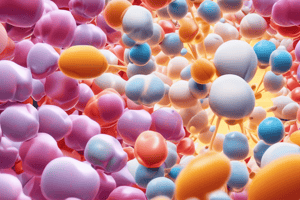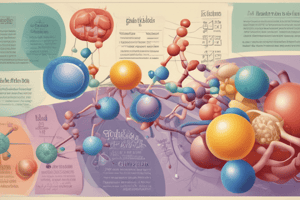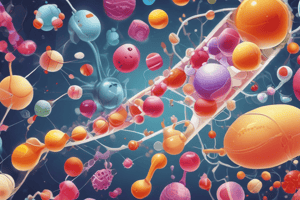Podcast
Questions and Answers
What is the function of vitamin K dependent carboxylase enzyme?
What is the function of vitamin K dependent carboxylase enzyme?
- To add a carboxy group to glutamic acid residues (correct)
- To remove a carboxy group from glutamic acid residues
- To convert glutamic acid to aspartic acid
- To break down glutamic acid residues
What is the result of vitamin K deficiency in newborn infants?
What is the result of vitamin K deficiency in newborn infants?
- Faster blood clotting
- Improved bone health
- Enhanced immune system
- Increased risk of hemorrhages (correct)
Why do patients with liver disease and biliary obstruction often have vitamin K deficiency?
Why do patients with liver disease and biliary obstruction often have vitamin K deficiency?
- Because the liver cannot store vitamin K
- Because bile salts are not produced in the liver
- Because the liver cannot absorb vitamin K
- Because bile salts cannot enter the intestine (correct)
What is the major site of vitamin E storage in the body?
What is the major site of vitamin E storage in the body?
What is the source of vitamin E in the diet?
What is the source of vitamin E in the diet?
How is vitamin E transported to target cells?
How is vitamin E transported to target cells?
What is the role of vitamin K in the body?
What is the role of vitamin K in the body?
What is the most active form of vitamin E?
What is the most active form of vitamin E?
What is vitamin K also known as?
What is vitamin K also known as?
What is the main function of vitamin K in the body?
What is the main function of vitamin K in the body?
What is the source of vitamin K1?
What is the source of vitamin K1?
How are naturally occurring vitamin K derivatives absorbed in the body?
How are naturally occurring vitamin K derivatives absorbed in the body?
What is the role of vitamin K in the activation of blood clotting factors?
What is the role of vitamin K in the activation of blood clotting factors?
What is vitamin K3?
What is vitamin K3?
What is the effect of vitamin K deficiency?
What is the effect of vitamin K deficiency?
Where is vitamin K stored in the body?
Where is vitamin K stored in the body?
Flashcards are hidden until you start studying
Study Notes
Vitamin K
- Vitamin K is an anti-hemorrhagic factor, and its deficiency produces uncontrolled hemorrhages due to defects in blood coagulation.
- There are two naturally occurring forms of vitamin K: vitamin K1 (phylloquinone) derived from plants, and vitamin K2 (menaquinones) produced by microorganisms.
- Vitamin K is also synthesized by microorganisms in the intestinal tract.
- Excellent sources of vitamin K include cabbage, cauliflower, spinach, and other green vegetables.
- Vitamin K is absorbed only in the presence of bile salts and is transported to the liver in the form of chylomicrons, where it is stored.
- Vitamin K plays a crucial role in blood coagulation, activating blood clotting factors (prothrombin, factor VII, IX, and X) through vitamin K-dependent carboxylation reactions.
- Vitamin K is also required for the carboxylation of glutamic acid residues of osteocalcin, a Ca2+ binding protein present in bone.
- Vitamin K deficiency is associated with hemorrhagic disease, characterized by increased clotting time and uncontrolled hemorrhages on minor injuries.
Vitamin K Deficiency
- Vitamin K deficiency is found in patients with liver disease and biliary obstruction, newborn infants, and individuals with fat malabsorption.
- Deficiency can also occur following antibiotic therapy that sterilizes the gut.
Vitamin E (Tocopherol)
- Vitamin E consists of eight naturally occurring tocopherols, with α-tocopherol being the most active form.
- The major dietary sources of vitamin E are fats and oils, with germ oil, corn oil, fish oil, and eggs being the richest sources.
- Vitamin E is absorbed from the intestine together with dietary lipid and is incorporated into chylomicrons, then delivered to the liver.
- The liver exports vitamin E into very low-density lipoprotein (VLDL) to target cells, where it is distributed to areas requiring antioxidant activity.
- The major site of vitamin E storage is in adipose tissue.
Studying That Suits You
Use AI to generate personalized quizzes and flashcards to suit your learning preferences.




